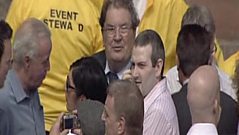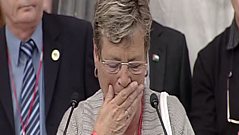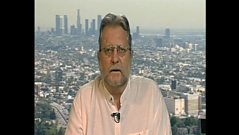
Soldiersâ solicitor responds to Saville report
Stephen Pollard, the solicitor for around 500 soldiers affected by the Bloody Sunday inquiry, responds to Lord Savilleâs conclusions.
On the day that Lord Savilleâs report into the events of Bloody Sunday is published (please see context below) Jim Fitzpatrick anchors a special Stormont Live programme. Here, Jim hands over to Political Reporter Stephen Walker who is outside the Houses of Parliament.
Stephen interviews Stephen Pollard, the solicitor representing around 500 of the soldiers affected by the Saville Inquiry.
Mr. Pollard states that he and his clients were very pleased by sections of Lord Savilleâs report. For example, they were pleased that Saville had found that any suggestion of collusion at government, army or unit level had not been the case.
He goes on to state: âEqually, there are elements of the report that suffer from a significant amount of cherry-picking of the evidence â and maybe using the evidence that fits the theory rather than giving a proper overview of the evidence that was given.â
Mr. Pollard asserts that at the start of the inquiry he had accepted that none of the dead and wounded had been doing anything that warranted their shooting.
Mr. Pollard defends Lieutenant Colonel Derek Wilford, the officer directly in charge of 1 Para on Bloody Sunday, arguing that he doesnât think Saville suggested that he had ignored orders. He believes there was an element of confusion surrounding the moment at which Colonel Wilford went into the Bogside.
Mr. Pollard feels that it has been the hidden agenda of some people involved in the inquiry that it would lead to the prosecution of soldiers, but he does not anticipate that there will be any prosecutions.
The Saville report had this to say regarding Lieutenant Colonel Derek Wilford:
3.18 Colonel Wilford did not comply with Brigadier MacLellanâs order. He deployed one company through Barrier 14 as he was authorised to do, but in addition and without authority he deployed Support Company in vehicles through Barrier 12 in Little James Street. As we describe below, the vehicles travelled along Rossville Street and into the Bogside, where the soldiers disembarked. The effect was that soldiers of Support Company did chase people down Rossville Street. Some of those people had been rioting but many were peaceful marchers. There was thus no separation between peaceful marchers and those who had been rioting and no means whereby soldiers could identify and arrest only the latter.
3.19 Colonel Wilford either deliberately disobeyed Brigadier MacLellanâs order or failed for no good reason to appreciate the clear limits on what he had been authorised to do. He was disturbed by the delay in responding to his request to mount an arrest operation and had concluded that, by reason of the delay, the only way to effect a significant number of arrests was to deploy Support Company in vehicles into the Bogside. He did not inform Brigade of this conclusion. Had he done so, Brigadier MacLellan might well have called off the arrest operation altogether, on the grounds that this deployment would not have provided sufficient separation between rioters and civil rights marchers.
CONTEXT
On 30 January 1972 soldiers from the 1st Parachute Regiment killed 13 innocent civil rights demonstrators in Derry.
The period from August 1971 to January 1972 saw a sustained campaign of anti-internment protests. On 22 January, John Hume led an illegal demonstration along Magilligan Strand just outside Londonderry, towards a nearby internment camp. The marchers were confronted by soldiers of the 1st Parachute Regiment who drove them off the beach using baton charges and rubber bullets.
It was these same paratroopers who were sent into Derry eight days later to deal with another banned protest. This march was organised by the Northern Ireland Civil Rights Association (NICRA). Some ten thousand people gathered in the Creggan estate and proceeded towards Guildhall Square in the centre of the city. The paratroopers had sealed off the approaches to the Square and the march organisers, in order to avoid trouble, led most of the demonstrators towards Free Derry Corner in the Bogside.
Groups of local youths (referred to by the security forces as âYDHsâ â Young Derry Hooligans) stayed behind at the Army barricades to confront the soldiers. The soldiers were ordered to move in and arrest as many of the rioters as possible. Just after four o'clock, the paratroopers made their move. What took place next was totally unexpected: the paratroopers opened fire on the crowd, killing thirteen men and injuring thirteen others; one of the injured died some time later.
The soldiers claimed that they had been fired on as they moved in to make arrests. As far as the people of the Bogside and further afield were concerned, the Army had summarily executed thirteen unarmed, innocent civilians. The Widgery Tribunal, which had been set up to investigate the circumstances surrounding the killings, later concluded that: âAt one end of the scale, some soldiers showed a high degree of responsibility; at the other end.... firing bordered on the recklessâ.
The Londonderry Coroner, Major Hubert O'Neill, did not share Lord Widgery's conclusion. At the end of the inquest in 1973, which is still seen by nationalists as a cover up for murder, O'Neill said, âIt strikes me that the army ran amok that day and they shot without thinking what they were doing⊠I say it without reservation - it was sheer unadulterated murderâ.
The British government later made out-of-court settlements with the bereaved families
In 1998 the Labour government launched an in-depth investigation chaired by Lord Saville of Newdigate. The Saville Inquiry, which was the most expensive investigation of its kind in the United Kingdom, reported in June 2010.
It concluded that none of the dead posed a threat and the actions of the soldiers were totally without justification. The Prime Minister David Cameron apologised on behalf of the nation for the âunjustified and unjustifiable killingsâ.
Duration:
This clip is from
More clips from Stormont Live Special - The Saville Inquiry Report
-
![]()
Publication of Saville Report
Duration: 11:42
-
![]()
Relatives of Bloody Sunday victims
Duration: 27:09
-
![]()
Early political reaction to the Saville report
Duration: 09:16
-
![]()
Interview with Tony Clarke
Duration: 03:41





